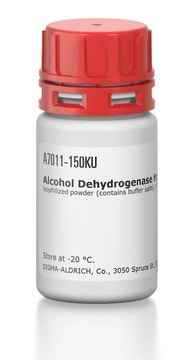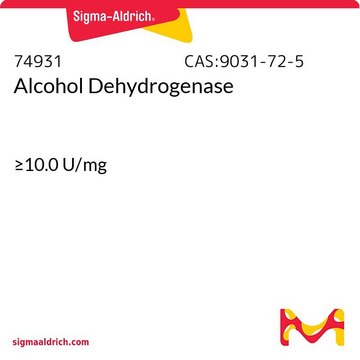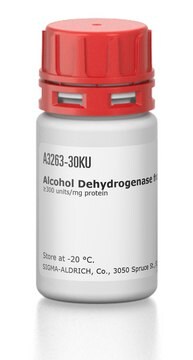55689
Alcohol Dehydrogenase equine
recombinant, expressed in E. coli, ≥0.5 U/mg
Sinónimos:
ADH
About This Item
Productos recomendados
origen biológico
equine
recombinante
expressed in E. coli
descripción
Isozyme E sequence
formulario
lyophilized powder
actividad específica
≥0.5 U/mg
color
white
light yellow
pH
7
solubilidad
water: 5 mg/mL
aplicaciones
life science and biopharma
temp. de almacenamiento
−20°C
Información sobre el gen
equine ... ADH1(111772995)
¿Está buscando productos similares? Visita Guía de comparación de productos
Descripción general
Alcohol dehydrogenase is a zinc metalloprotein that forms five classes of isoenzymes through the dimerization of eight different subunits.
Aplicación
Acciones bioquímicas o fisiológicas
Definición de unidad
Palabra de señalización
Danger
Frases de peligro
Consejos de prudencia
Clasificaciones de peligro
Resp. Sens. 1
Código de clase de almacenamiento
11 - Combustible Solids
Clase de riesgo para el agua (WGK)
WGK 1
Punto de inflamabilidad (°F)
Not applicable
Punto de inflamabilidad (°C)
Not applicable
Certificados de análisis (COA)
Busque Certificados de análisis (COA) introduciendo el número de lote del producto. Los números de lote se encuentran en la etiqueta del producto después de las palabras «Lot» o «Batch»
¿Ya tiene este producto?
Encuentre la documentación para los productos que ha comprado recientemente en la Biblioteca de documentos.
Nuestro equipo de científicos tiene experiencia en todas las áreas de investigación: Ciencias de la vida, Ciencia de los materiales, Síntesis química, Cromatografía, Analítica y muchas otras.
Póngase en contacto con el Servicio técnico







